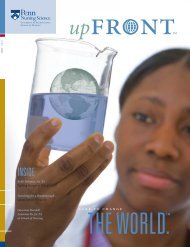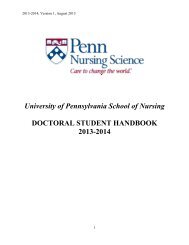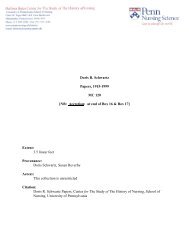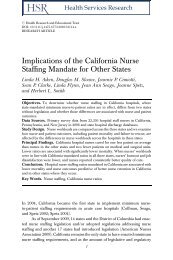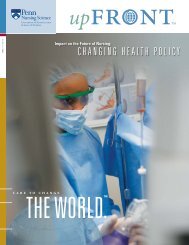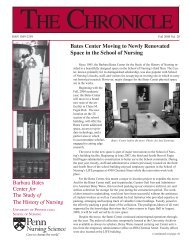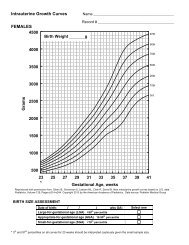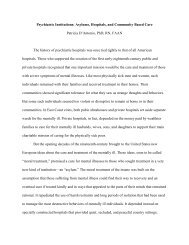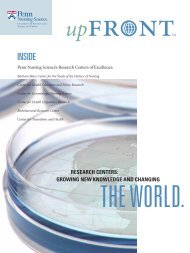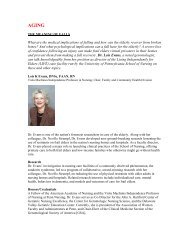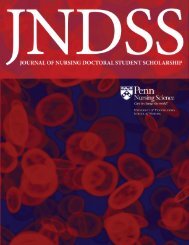Penn Nursing 090805_final_4c - University of Pennsylvania School ...
Penn Nursing 090805_final_4c - University of Pennsylvania School ...
Penn Nursing 090805_final_4c - University of Pennsylvania School ...
Create successful ePaper yourself
Turn your PDF publications into a flip-book with our unique Google optimized e-Paper software.
Collaboration Advances<br />
Sleep Research<br />
Terri E. Weaver<br />
PhD, FAAN, RN, CS<br />
Associate Pr<strong>of</strong>essor <strong>of</strong> <strong>Nursing</strong>; Chair,<br />
Biobehavioral and Health Sciences Division<br />
In the field <strong>of</strong> sleep research, collaboration<br />
between <strong>Penn</strong>’s <strong>Nursing</strong> <strong>School</strong><br />
and other disciplines within the<br />
<strong>University</strong> <strong>of</strong> <strong>Penn</strong>sylvania is producing<br />
advances that would not be possible<br />
without an interdisciplinary approach.<br />
A combination <strong>of</strong> different<br />
approaches to work on sleep deprivation,<br />
for example, have been taken by<br />
the Center for Sleep and Respiratory<br />
Neurobiology, the <strong>Nursing</strong> <strong>School</strong>’s<br />
Biobehavioral and Health Sciences<br />
Division, and Associate Pr<strong>of</strong>essor <strong>of</strong><br />
<strong>Nursing</strong> Ann E. Rogers, PhD, RN,<br />
FAAN in a way that advances knowledge.<br />
At the same time, a <strong>Penn</strong> <strong>Nursing</strong><br />
investigation <strong>of</strong> a link between hypoglycemia<br />
and sleep in long-term diabetic<br />
patients has been aided by collaboration<br />
with <strong>Penn</strong>’s Veterinary <strong>School</strong>,<br />
whose work with rats provided valuable<br />
data for the project.<br />
One whose research has created<br />
new science is Terri E.Weaver, PhD,<br />
FAAN, RN, CS,Associate Pr<strong>of</strong>essor and<br />
Chair <strong>of</strong> the Biobehavioral and Health<br />
Sciences Division at the <strong>School</strong> <strong>of</strong><br />
<strong>Nursing</strong>. Dr.Weaver’s work on<br />
Obstructive Sleep Apnea (OSA), a condition<br />
in which sleep is interrupted by<br />
involuntary blocking <strong>of</strong> the patient’s airway,<br />
has been informed and enhanced<br />
by her work with the Sleep Center at<br />
the Hospital <strong>of</strong> the <strong>University</strong> <strong>of</strong><br />
<strong>Penn</strong>sylvania.<br />
The breadth <strong>of</strong> expertise on sleep<br />
research that is available at <strong>Penn</strong> can be<br />
brought to bear on various research<br />
questions.“Between the <strong>Nursing</strong><br />
<strong>School</strong>, the Veterinary <strong>School</strong> and<br />
medical staff, we have 36 faculty members<br />
from a variety <strong>of</strong> disciplines working<br />
on the issues and mysteries <strong>of</strong><br />
sleep,” she says.“It’s one <strong>of</strong> the best<br />
centers in the world.”<br />
Collaboration with the Sleep<br />
Center has played an important role in<br />
Dr.Weaver’s recent work on sleep<br />
apnea.Working with David Dinges,<br />
PhD, a nationally known psychologist<br />
associated with the <strong>School</strong> <strong>of</strong><br />
Medicine, and others, Dr.Weaver’s<br />
study focused on why some OSA<br />
patients are sleepy and some are not.<br />
Factors considered include age, gender,<br />
illness, and the effects <strong>of</strong> medication<br />
on their sleeping patterns.<br />
During the second stage <strong>of</strong> the<br />
study, patients were sent home with a<br />
portable device that would allow them<br />
to record their own sleep patterns for<br />
seven days to determine whether<br />
alterations in respiratory disturbances<br />
affect their sleepiness. Finally, the participants<br />
were treated for four weeks<br />
with Continuous Positive Airway<br />
Pressure (CPAP), a device designed to<br />
keep the patient’s airway open during<br />
sleep followed by a 38-hour sleep<br />
deprivation to see if a biological trait<br />
contributes to sleepiness.<br />
Obstructive Sleep Apnea, a condition<br />
that affects four percent <strong>of</strong> men<br />
and two percent <strong>of</strong> women, can occur<br />
up to 50 or 60 times an hour during a<br />
patient’s sleep, Dr.Weaver says.<br />
When apnea begins, the restricted<br />
intake <strong>of</strong> air and oxygen arouses the<br />
patient to a lighter stage <strong>of</strong> sleep and<br />
gasping for air.When the pathway<br />
<strong>final</strong>ly reopens, the patient falls into<br />
deeper sleep, and the cycle begins<br />
anew. OSA is a potentially dangerous<br />
condition that is associated with cardiovascular<br />
disease and diabetes. It<br />
mostly affects middle-aged people, particularly<br />
the obese, although the link<br />
with obesity is not fully understood,<br />
Dr.Weaver says. Others prone to the<br />
condition are those whose facial anatomy<br />
makes them predisposed to airway<br />
obstruction.<br />
The loss <strong>of</strong> quality sleep contributes<br />
to excessive daytime sleepiness,<br />
which in turn impairs functions such as<br />
reaction time, memory, thinking, planning,<br />
and mood.<br />
(continued on next page)<br />
Left to right: Post-doctoral fellow Judy L. Reishtein, PhD, CCRN, RN, David Dinges, PhD, Pr<strong>of</strong>essor <strong>of</strong> Psychology in the<br />
<strong>School</strong> <strong>of</strong> Medicine, and Dr. Weaver review their data.<br />
9




